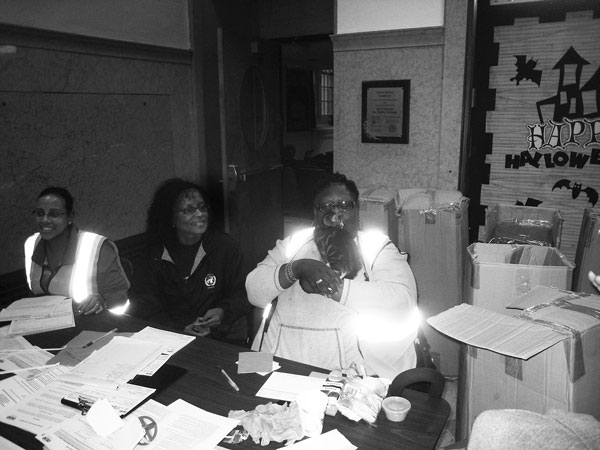
BY LESLEY SUSSMAN | They walked in carrying bulging backpacks and luggage, plus a few precious household items. Some brought cats, dogs and a favorite plant or two. They were trying to escape a storm considered so potentially dangerous that the city had issued a mandatory evacuation order for people who lived in the housing projects along F.D.R. Drive and elsewhere east of Avenue B all the way to Avenue D.
The scene late Monday afternoon at the former Seward Park High School, 350 Grand St., now the campus for five different small schools, which had been turned into an emergency evacuation center, looked like something out of some post-apocalyptic sci-fi movie as more than 500 people forced to leave their homes filled the corridors, auditorium and gyms of the school building. Also among their number were homeless people who had abandoned their usual outdoor sleeping spots as Hurricane Sandy was bearing down on the city.
Old and young packed the George Comet Theater Auditorium where they sat with eyes glued to the NY1 News weather report on a color TV screen, while others tried to relax on cots provided by the city and wait for dinner to be served.
Many just wandered back and forth along the long corridor with a makeshift emergency clinic at one end of it, looking a bit dazed. Meanwhile, kids — some of them wearing Halloween costumes and under the watchful eye of anxious parents — did their utmost to amuse themselves.
“We have no idea how many people we’re going to have to handle,” said Richard Gorgoglione, the evacuation center’s manager, an employee of the city’s Office of Emergency Management.
“Most of them came yesterday and we have 500 people here right now,” he said. “We feed them, give them bedding and toilet facilities and a safe place to stay. We can take up to 900 people.”
Gorgoglione said that three hot meals a day would be served. Doing the grunt work of registering people, helping them get settled and serving meals were dozens of workers from various city agencies who live in the evacuation area and volunteered to man the emergency shelter instead of reporting to work.
The city worker said he had been through this once before — during last year’s hurricane that downgraded to a tropical storm — and did not feel overwhelmed by the task at hand.
“We’re trained for this,” he said. “We watched the weather and here we are.”
At least one volunteer, a woman who asked that her name not be used, said that she had been at the shelter since 8 a.m. on Sunday.
“I may have to stay over one more night,” she sighed, while petting a cat that someone had brought into the shelter. “I’m totally exhausted.”Robert Torres, who said he was homeless, liked the arrangement.
“It’s nice here,” he said. “We’re sleeping on cots and not on the floor and we’re getting breakfast, lunch and dinner.”
Diane Vernon, a resident of the Lillian Wald Houses along F.D.R. Drive, said she came because of fears that the power might go out and the water would be cut off in her public housing development.
“I brought my daughter and my cat and I feel safer here,” she said.
Elsewhere late Monday afternoon throughout the East Village and Lower East Side, and judging by the packed bars and restaurants along Ludlow, Eldridge and Rivington Sts., most young people seemed to be enjoying their day off from work.
Meanwhile, along Avenue A, many stores, bars and restaurants remained open for business — including the packed Key Food supermarket on the corner of E. Fourth St.
Further east, along Avenues B, C and D, business owners seemed to be taking the storm warnings and evacuation notice seriously and had shuttered their establishments.
All day Sunday and Monday, the long lines of people at the Key Food supermarket seemed to rival that of Trader Joe’s on E. 14th St. On Sunday the line of people waiting to get into the Trader Joe’s wine shop annex was as long as the one outside the main store.
At Key Food, there was a party atmosphere among many of the younger customers, who seemed torn between looking at their smart phone screens and reading and sending text messages versus shopping.
Most of the shopping carts were filled with bottles of water, bread and canned goods, and there were also plenty of frozen pizzas and beer in sight. One shelf in the store that was completely empty was the one that had contained cans of black beans.
Joe Vacinni, a fill-in worker at the Key Food, said the supermarket had almost run out of water and bread, and that clerks working the cash registers were on the verge of exhaustion trying to handle the never-ending, long lines of customers.
“It’s like the end of the world,” Vacinni said, and one elderly man who heard him staunchly agreed.
“The world is going to end at 7 p.m. tonight,” the older man shouted, to the amusement of many of those standing nearby
“I wish it would,” one young freak dressed all in black with dyed green hair and devils’ faces tattooed on his wrists replied aloud. “The hell with this world and Key Food.”

















